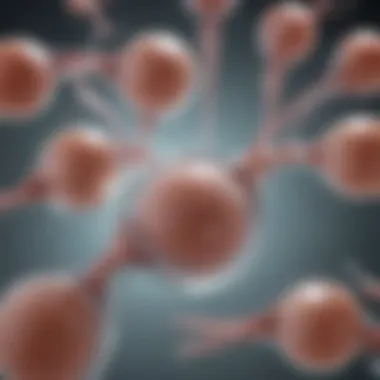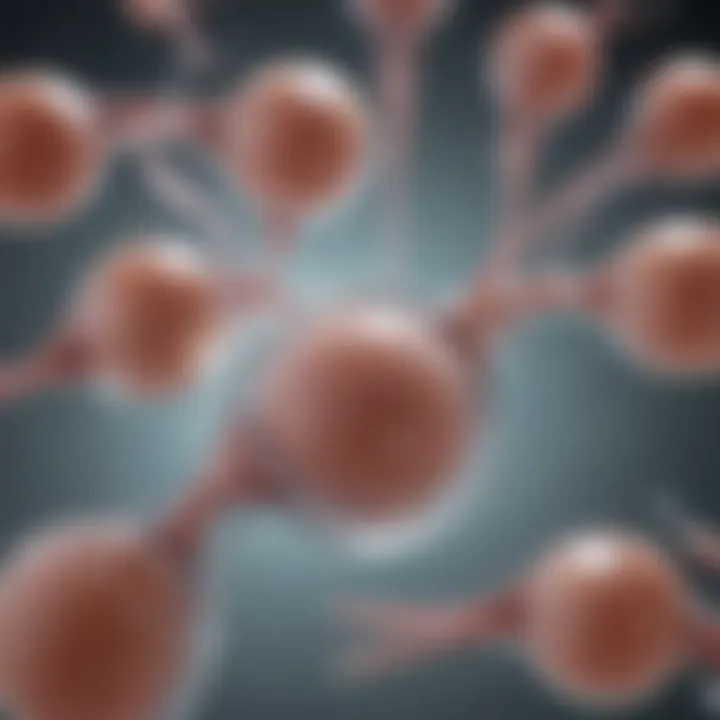An Overview of Assisted Reproductive Technology


Intro
Assisted Reproductive Technology (ART) is a complex and evolving field aimed at addressing infertility challenges faced by individuals and couples. It encompasses a range of procedures designed to facilitate conception through various methods that manipulate human reproductive processes. The demand for ART has increased markedly over the years, driven by factors such as delayed parenthood, reproductive health issues, and broader availability of fertility treatments. Understanding ART requires a deep dive into its methodologies, applications, and the science that underpins these techniques.
Research Overview
Key Findings
Research in the realm of ART has unveiled several critical insights. Notable findings demonstrate that techniques such as In Vitro Fertilization (IVF) and Intracytoplasmic Sperm Injection (ICSI) have significantly improved success rates for couples experiencing infertility. Moreover, advancements in genetic testing have provided couples with options to screen embryos for hereditary disorders, ultimately influencing their choices regarding family planning. The varied success rates and outcomes are subject to numerous factors, including maternal age, underlying health conditions, and even embryonic development stages.
Study Methodology
The methodologies used in recent studies encompass both quantitative and qualitative approaches. Many studies rely on large patient populations to gauge reproductive outcomes, while others employ case studies to explore the emotional and psychological aspects of undergoing ART. Data is often collected from fertility clinics, offering insights into procedural efficacy and patient satisfaction. This comprehensive approach allows researchers to develop a more nuanced understanding of ART effectiveness and patient experience.
Background and Context
Historical Background
ART traces its origins back to the late 20th century, with the first successful IVF procedure taking place in 1978. Since then, the field has grown exponentially with considerable advancements that have revolutionized reproductive medicine. Techniques such as egg freezing and preimplantation genetic diagnosis have emerged to provide couples with greater flexibility and options. As societal attitudes towards parenthood and infertility have shifted, so too has the landscape of ART, leading to broader acceptance and integration into mainstream healthcare.
Current Trends in the Field
Today, ART is witnessing various trends that reflect advancements in both technology and societal norms. Personalized treatment plans based on genetic profiling are gaining traction, offering tailored solutions for couples. Furthermore, the increasing focus on male fertility highlights the need for a more holistic approach to reproductive health. The incorporation of artificial intelligence and machine learning into fertility clinics is also reshaping how treatments are delivered, enhancing efficiency and patient outcomes.
"The evolution of ART technologies is not just about helping individuals conceive; it is about understanding the fundamental biological processes that govern reproduction."
Prelude to Assisted Reproductive Technology
Assisted Reproductive Technology, commonly known as ART, encompasses a range of medical interventions designed to assist individuals and couples facing infertility challenges. The relevance of this topic lies not only in its growing importance in modern healthcare but also in its transformative effects on family planning and reproductive autonomy. In recent decades, advancements in ART have progressed significantly, integrating sophisticated technologies with medical science. This article aims to present a thorough examination of ART, along with the myriad techniques it involves and their practical applications.
The benefits of ART are multifold. It provides opportunities for conception where natural methods may fail due to various reasons—age-related factors, medical conditions, or genetic issues. Furthermore, ART holds the potential for addressing the reproductive needs of single individuals, same-sex couples, and those requiring donor gametes. Given this wide application, understanding both the definition and historical evolution of ART is critical.
Beyond practical applications, ART also invites a variety of considerations. Patients often face emotional challenges during treatment, alongside financial implications of procedures like In Vitro Fertilization (IVF) or Intracytoplasmic Sperm Injection (ICSI). Therefore, it is crucial to approach ART not merely as a series of medical procedures but as a complex interplay of biological, ethical, and emotional dynamics, all of which must be navigated with care.
Definition and Scope of ART
Assisted Reproductive Technology broadly refers to any treatment specifically designed to address infertility through artificial or partially artificial means. This includes technologies that manage and assist in the conception process. ART primarily involves manipulating either sperm, eggs, or embryos outside of the human body. Medical professionals use these methods to increase the chance of pregnancy for individuals and couples experiencing difficulty.
Common ART methodologies include In Vitro Fertilization (IVF), Intracytoplasmic Sperm Injection (ICSI), and Gamete Intrafallopian Transfer (GIFT), among others. Each technique utilizes a different approach and is selected based on individual circumstances and needs.
Historical Context of ART
The roots of Assisted Reproductive Technology can be traced back several decades. The journey began in the late 1970s with the successful birth of Louise Brown, the first test tube baby, born through IVF. This landmark event marked a significant breakthrough in reproductive medicine, paving the way for subsequent advancements.
Over the years, research has expanded into various methodologies and applications. By the late 1980s and early 1990s, more sophisticated techniques such as ICSI emerged, allowing for improved outcomes, particularly in cases of male infertility. Each decade brought innovative practices that revolutionized patient care in reproductive health.
Today, ART reflects a confluence of medical science, technology, and ethics. With ongoing research, the scope continues to expand, enabling researchers and practitioners to explore new dimensions in reproductive health. As this field evolves, it is essential to stay informed about both the potential and the limitations of ART.
In Vitro Fertilization (IVF)
In Vitro Fertilization, commonly known as IVF, is a cornerstone of assisted reproductive technology. This method represents a breakthrough for individuals and couples encountering difficulty with conception. The implications of IVF extend beyond mere biology; it embodies hope and scientific advancement that can significantly alter reproductive choices. This section will elaborate on the various components and procedures of IVF, showcasing both its methodologies and merits while also addressing some of the associated challenges.
Overview of IVF
In Vitro Fertilization involves the fusion of eggs and sperm outside the human body. This is typically performed in a laboratory setting. IVF facilitates conception for many who face infertility due to various reasons such as blocked fallopian tubes, ovulation disorders, or sperm quality issues.
The mechanism of IVF not only assists with conception but also allows for genetic screening before implantation, providing insights into potential hereditary conditions. This capability makes IVF a multifaceted solution, as it empowers couples to make informed reproductive choices.
IVF Procedure Steps
The IVF process consists of several significant steps that ensure the highest chance of successful conception. Understanding each component is essential for appreciating the overall function of IVF.
Ovarian Stimulation
Ovarian stimulation is the first step in the IVF process. During this phase, hormonal medications are administered to encourage the ovaries to produce multiple eggs instead of the single egg that typically forms during a natural menstrual cycle. This is crucial because having multiple eggs increases the possibility of fertilization and successful embryo formation.
The benefit of ovarian stimulation lies in its ability to maximize reproductive potential in a limited timeframe. However, there are also risks, such as the development of ovarian hyperstimulation syndrome, which must be carefully monitored.
Oocyte Retrieval
Following successful ovarian stimulation, oocyte retrieval is performed. This procedure involves the surgical extraction of the mature eggs from the ovaries. A thin needle is guided through the vaginal wall and into the ovaries using ultrasound imaging.
A distinctive feature of oocyte retrieval is its minimally invasive nature. While some discomfort may occur, sedation options are usually provided, ensuring patient comfort. This step is critical, as the quality and quantity of retrieved eggs directly impact the success rates of IVF.
Fertilization Process
Once the eggs are retrieved, they are combined with sperm in the laboratory. The fertilization process usually allows sperm to penetrate the egg naturally, although techniques like ICSI can be employed if sperm motility is an issue.
This step of fertilization is vital for creating viable embryos. The fertilization method chosen can influence embryo quality and the likelihood of implantation success. Both natural fertilization and assisted methods produce different outcomes, which can be evaluated during embryo culture.
Embryo Culture
During embryo culture, fertilized eggs are monitored for embryo development. This period allows embryos to grow to a specific stage before transfer. Typically, embryos are cultured for 3 to 5 days.


The key benefit of embryo culture is it enables embryologists to select the best-quality embryos for transfer based on developmental criteria. However, maintaining optimal conditions for embryo culture is complex and requires specialized laboratory equipment and expertise.
Embryo Transfer
The final step of the IVF process is embryo transfer. Here, one or more of the best-quality embryos is placed into the uterus. This is done using a small catheter that is inserted through the cervix.
Embryo transfer is relatively straightforward and non-invasive, but it can be emotionally charged as patients await the outcome. A successful transfer leads to implantation, where the embryo attaches to the uterine lining and begins the process of pregnancy.
Success Rates and Factors
The effectiveness of IVF is affected by various factors including the age of the woman, the underlying reasons for infertility, embryo quality, and the specific techniques used during the IVF cycle. Statistically, younger women tend to have higher success rates due to better egg quality.
Indeed, it is crucial to view IVF not just as a process, but as a multifactorial journey. Engaging with healthcare professionals to discuss individual circumstances and personalized protocols enhances the chances of success.
Understanding all these elements of IVF reveals its significance in assisted reproductive technology. It remains a regularly employed option to address various challenges in reproduction, exemplifying its importance in modern medicine.
Intracytoplasmic Sperm Injection (ICSI)
Intracytoplasmic Sperm Injection, or ICSI, is an advanced fertilization technique utilized in assisted reproductive technology. This method specifically addresses male infertility factors by enabling the direct injection of a single sperm into an oocyte, creating a pathway to conception where traditional methods may fail. As a pivotal application of ART, ICSI has significantly enhanced the chances of pregnancy for couples struggling with infertility issues related to sperm quality or quantity.
Prelude to ICSI
ICSI was developed in response to the challenges faced by couples experiencing male-factor infertility. This technique marks a significant advancement in reproductive medicine. It is defined as a specialized form of in vitro fertilization (IVF) that requires careful manipulation of both the sperm and egg.
The inception of ICSI traces back to the early 1990s, primarily as a solution to overcome obstacles like low sperm count or motility. As a result, ICSI has become a cornerstone in the toolkit of fertility specialists, with thousands of successful procedures performed annually.
ICSI Technique
The ICSI process can be broken down into several precise steps, each critical to the successful creation of embryos.
- Ovarian Stimulation: The first step involves hormonal treatments to stimulate the ovaries for the production of multiple oocytes.
- Oocyte Retrieval: Following stimulation, a minor surgical procedure is conducted to retrieve the matured oocytes from the ovaries.
- Sperm Selection: Semen is prepared to isolate the most viable sperm. The technique emphasizes the careful choice of a suitable sperm, often through microscopic examination.
- Injection of Sperm: A single sperm is then injected directly into the cytoplasm of the oocyte using a fine needle.
- Embryo Culture: The fertilized oocyte is cultured to allow development into one or more embryos.
- Embryo Transfer: Finally, the viable embryos are transferred into the uterus, following standard IVF procedures.
Applications and Considerations
ICSI’s applications are broad, extending to various fertility challenges. Its most notable application is in cases of severe male-factor infertility but is also beneficial for couples with unexplained infertility or those undergoing preimplantation genetic testing.
However, there are several considerations attached to this technique:
- Success Rates: While ICSI has improved fertilization rates, it is not a guaranteed pathway to pregnancy. Outcomes vary based on age, cause of infertility, and overall health.
- Possible Risks: The potential for genetic abnormalities exists, often due to the selection of sperm with limited genetic diversity. Additionally, the procedure itself carries risks of injury to the oocyte or surrounding tissues.
- Ethical Concerns: As is the case with all advanced reproductive technologies, ethical considerations surrounding ICSI persist. Issues may include the fate of unused embryos and the accessibility of these services.
Gamete Intrafallopian Transfer (GIFT)
Gamete Intrafallopian Transfer (GIFT) is a notable method in assisted reproductive technology. This technique, while less commonly discussed than others like IVF or ICSI, offers a unique approach to fertility treatment. GIFT involves placing both eggs and sperm directly into the fallopian tubes, where fertilization can occur naturally. This concept mimics the body’s natural reproductive process more closely than other ART methods.
Understanding GIFT
GIFT is essential for certain groups facing infertility. It becomes particularly relevant for couples where eggs are retrieved, but there are concerns related to fertilization in vitro. The process allows for a natural environment for fertilization, which can be beneficial for both the egg and sperm quality. An important aspect of GIFT is its requirement for at least one functioning fallopian tube in the female. Thus, it is most suitable for women who are not completely obstructed.
GIFT Procedure Explained
The GIFT procedure consists of several critical steps:
- Ovarian Stimulation: Hormonal medications are administered to stimulate the ovaries to produce multiple eggs.
- Monitoring: The development of follicles is monitored through ultrasound and blood tests to determine the optimal time for egg retrieval.
- Oocyte Retrieval: Once the eggs are ready, they are extracted from the ovaries using a minor surgical procedure.
- Sperm Collection: A sperm sample is obtained from the male partner or a donor.
- Gamete Transfer: The eggs and sperm are combined and immediately transferred into the fallopian tubes using a laparoscopic procedure.
This method limits the time between oocyte retrieval and fertilization, which is considered advantageous. The direct placement in the fallopian tube minimizes exposure to unfavorable conditions which might be present in vitro.
GIFT's Role in Fertility Treatment
In fertility treatments, GIFT has distinct advantages. It provides an option for couples who may wish to avoid in vitro fertilization due to personal or medical reasons. Notably, GIFT is also beneficial for certain infertility diagnoses, such as unexplained infertility or for those with specific male factor infertility issues. Since fertilization happens in the natural environment of the fallopian tubes, some studies suggest that this approach may lead to a more favorable embryo development. Furthermore, GIFT allows for the possibility of multiple pregnancies, which while a risk, can also be a desired outcome for some couples.
"GIFT can offer a viable alternative for select couples, preserving the natural process of fertilization."
While GIFT is not as widely practiced as IVF, it still holds relevance within the realm of assisted reproductive technology. Its unique approach to fertilization can be a helpful solution for those facing particular reproductive challenges.
Zygote Intrafallopian Tube Transfer (ZIFT)
Zygote Intrafallopian Tube Transfer, commonly known as ZIFT, is a significant advancement in the realm of assisted reproductive technology. It plays a crucial role in addressing certain infertility issues, primarily through enriching the options available to couples encountering difficulties in conceiving naturally. Unlike other methods, ZIFT combines features from both in vitro fertilization and a more natural approach of fertilization within the fallopian tubes. This technique warrants a detailed exploration due to its unique benefits and applications.
What is ZIFT?
ZIFT is a procedure that involves the transfer of a zygote, which is a fertilized egg, directly into the fallopian tube. This method is typically chosen when there are potential issues with fertilization due to female reproductive factors, such as blocked fallopian tubes or when IVF has previously been unsuccessful. The main premise of ZIFT is to allow for natural implantation processes after fertilization. When applied, it seeks to optimize the environment where an embryo can develop successfully compared to solely relying on external incubation in a laboratory setting.
ZIFT Procedure Details
The ZIFT procedure encompasses several critical steps that are paramount for its success:
- Ovarian Stimulation: Hormonal treatments are administered to stimulate the ovaries, promoting the development of multiple follicles that typically contain eggs.
- Oocyte Retrieval: Once the eggs are sufficiently mature, they are retrieved using a fine needle guided by ultrasound.
- Fertilization in the Laboratory: The retrieved oocytes are fertilized by sperm in a laboratory environment. This results in the formation of a zygote, which is an early-stage embryo at the time of transfer.
- Zygote Transfer: Instead of transferring embryos, a zygote is placed into the fallopian tube, typically within 24 hours of fertilization. This step is executed with precision using a specialized catheter.
- Monitoring and Follow-Up: Post-transfer, hormone supplements are often prescribed to support uterine lining and pregnancy establishment, along with regular follow-ups to monitor progress.
Benefits and Limitations of ZIFT
ZIFT offers a blend of advantages and challenges, which are important to consider in the context of assisted reproductive technology:
Benefits


- Natural Environment for Embryo Development: By placing the zygote directly in the fallopian tube, ZIFT utilizes the body’s natural reproductive physiology, which can enhance chances of successful implantation and development.
- Potential Solutions for Specific Infertility Issues: It addresses cases where traditional IVF might fail due to anatomical issues, offering an alternative path to conception.
Limitations
- Complexity of the Procedure: ZIFT is more technically demanding compared to other methods like standard IVF, requiring expert handling of the zygote and precise timing.
- Availability: Not all fertility clinics offer ZIFT, and it may not be accessible to all patients.
"ZIFT provides a unique blend of laboratory precision and natural physiological processes, targeting specific infertility challenges."
In summary, ZIFT represents a crucial tool within assisted reproductive technology, especially for couples facing particular infertility challenges. Its hybrid method of fertilization and transfer seeks to improve outcomes while allowing for a natural progression of embryo development.
Assisted Hatching
Assisted hatching represents a significant advancement in the landscape of assisted reproductive technology. This technique aims to improve the chances of embryo implantation by facilitating the process of hatching. In natural conception, embryos hatch from their protective shell, known as the zona pellucida, to implant into the uterine lining. This is a crucial step, and any barriers to it may result in failed implantation. The essence of assisted hatching lies in its ability to enhance the likelihood of successful pregnancy outcomes in certain populations, particularly those facing complex fertility challenges.
Definition and Purpose
Assisted hatching is defined as a laboratory technique applied to embryos before implantation. Its primary purpose is to assist the embryo in breaking free from the zona pellucida. This outer shell can sometimes be particularly thick or impenetrable, hindering the embryo’s ability to hatch. The intervention can be particularly beneficial for older women, those with previous failed IVF cycles, or embryos derived from frozen eggs. By creating a small opening in the zona pellucida, the technique enables the embryo to escape more easily, potentially increasing rates of successful implantation and subsequent pregnancy.
Techniques in Assisted Hatching
There are several techniques used in assisted hatching, and each varies in their approach to assist the embryo. Common methods include:
- Mechanical Hatching: This involves physically creating an opening in the zona pellucida using a fine needle. This technique is straightforward but requires careful manipulation.
- Chemical Hatching: This method uses acid or other chemicals to weaken the zona pellucida, promoting easier hatching. While effective, the application of chemicals must be meticulously controlled to avoid any damage to the embryo.
- Laser Hatching: A more advanced approach, laser hatching utilizes a focused beam of light to create a precise opening in the zona pellucida. This technique is increasingly favored due to its accuracy and minimal risk of harm to the embryo.
These techniques reflect a thoughtful approach to enhancing embryonic development and improving reproductive outcomes.
Research on Assisted Hatching Effectiveness
The effectiveness of assisted hatching has been a subject of investigation in various studies over the years. Some research has indicated that assisted hatching may have a positive impact on implantation rates, especially in specific demographics such as women over 35 years old, those with diminished ovarian reserve, or repeated IVF failures.
Nevertheless, the evidence is mixed, and not all studies reach the same conclusion. Some investigations suggest that assisted hatching may not be necessary for all patients undergoing IVF. Therefore, practitioners often assess individual cases to decide whether to implement this technique. Patients should be informed of both the potential benefits and the limitations of assisted hatching as part of their fertility treatment journey.
"Assisted hatching can be a valuable addition in the arsenal of ART methodologies, but its utility should be assessed on a case-by-case basis, prioritizing patient-specific factors."
Cryopreservation Techniques
Cryopreservation techniques play a critical role in assisted reproductive technology (ART). They allow for the long-term preservation of gametes, embryos, and reproductive tissue. As an essential component of modern ART, cryopreservation enables individuals and couples to preserve their fertility for future use. This section delves into the key aspects of cryopreservation, examining its methods, processes, and implications.
Overview of Cryopreservation
Cryopreservation is the process of cooling and storing biological samples at very low temperatures. This stabilization prevents cellular activity, including metabolism and degradation. The use of cryopreservation in ART began in the late 20th century, leading to significant advancements in fertility treatments. Its main objective is to allow for the preservation of sperm, eggs, and embryos, creating more opportunities for successful pregnancies over time.
The importance of cryopreservation extends beyond individual fertility treatments. It contributes to research and genetic studies. Many fertility clinics now have the capability to offer cryopreservation, reflecting its established role in the field. However, ethical considerations and regulations surrounding the process continue to evolve.
Sperm and Egg Freezing Methods
Sperm and egg freezing are both widely utilized cryopreservation techniques:
- Sperm Freezing: The method involves collecting sperm samples, usually through ejaculation. The samples are then prepared in a laboratory setting by mixing them with a cryoprotectant, which protects the cells during the freezing process. The sperm is then cooled slowly before being stored in liquid nitrogen. This effective method preserves sperm viability for years.
- Egg Freezing (Oocyte Cryopreservation): This technique is more complex due to the structure of eggs. Ovarian stimulation is first performed to retrieve multiple eggs. Once harvested, the eggs are treated with a cryoprotectant and then cooled. There are two primary methods for freezing eggs: slow freezing and vitrification. Vitrification is a rapid freezing process that prevents ice crystal formation, leading to higher survival rates.
Both methods are crucial for individuals who wish to delay parenthood or those undergoing medical treatments that may impact fertility.
Storage and Thawing Process
The storage of cryopreserved samples typically occurs in liquid nitrogen tanks. This environment maintains a steady temperature of approximately -196°C. This state of preservation is essential since even slight temperature fluctuations can affect sample viability. Storage facilities must meticulously monitor nitrogen levels and ensure that samples are securely stored.
Thawing is another critical step. The procedures used in thawing vary depending on whether the sample is sperm or eggs. For instance, sperm samples may be thawed quickly at body temperature, while thawing eggs requires careful handling to prevent cellular damage. There are established protocols to ensure that thawed gametes or embryos retain their functionality.
"Cryopreservation has revolutionized the field of reproductive medicine, making it possible for many to achieve their family goals even in challenging circumstances."
As medical professionals and researchers continue to explore these methodologies, the future of cryopreservation is promising.
Oocyte Donation
Oocyte donation plays a crucial role in assisted reproductive technology (ART), offering hope to individuals and couples struggling with infertility. This process enables those who cannot produce viable eggs to conceive, thereby expanding the opportunities for family building. Oocyte donation is not simply about the transfer of eggs; it involves a complex interplay of biological, emotional, and ethical considerations.
Understanding Oocyte Donation
Oocyte donation involves the retrieval of eggs from a donor, which are then fertilized with sperm in a laboratory setting, creating embryos that can be implanted into a recipient. This method is often used by women who experience conditions such as premature ovarian failure, age-related decline in fertility, or genetic disorders. The benefits of oocyte donation include:
- Higher Success Rates: Women using donated eggs generally exhibit higher success rates compared to those relying on their own eggs, particularly if they are of advanced maternal age.
- Genetic Considerations: Oocyte donation allows recipients to avoid genetic disorders that may be present in their own eggs.
- Flexible Options: Recipients can select from a diverse pool of donors based on various criteria, allowing for personalized choices in the donation process.
The process begins with careful donor selection, often guided by a fertility clinic. Potential donors undergo comprehensive medical and psychological evaluations to ensure both their health and the health of future offspring.
Legal and Ethical Considerations
The legal and ethical dimensions of oocyte donation are multifaceted and require careful navigation to protect all parties involved. Key considerations include:
- Informed Consent: Donors must provide informed consent, fully understanding the implications of their decision, including the potential for future contact with offspring.
- Anonymity vs. Openness: Some jurisdictions allow anonymous donations, while others may open pathways for donors and recipients to know more about one another, raising questions about privacy and personal rights.
- Compensation Regulations: The issue of compensating donors is complex. Various countries have different laws regarding how much and in what manner donors can be compensated.
- Emotional and Psychological Impacts: The psychological effects on both donors and recipients are significant, necessitating counseling and support throughout the process.
"Oocyte donation is not just a medical procedure; it represents profound life choices for all involved, including ethical implications that cannot be overlooked."
Navigating these legal and ethical landscapes is crucial to ensuring that all parties are protected and that the donation process is respectful and transparent. Oocyte donation stands as a testament to the advancements in reproductive technology, yet it also compels society to reflect on the responsibilities that come with such abilities.


Sperm Donation
Sperm donation plays a crucial role in assisted reproductive technology, providing a solution for individuals and couples facing infertility. The importance of sperm donation is amplified in scenarios where male infertility is a factor, or when same-sex couples and single women seek to conceive. The process allows for the potential creation of families that might otherwise face significant challenges. It raises essential questions about genetic links, parenting, and the rights of the donor.
Insights into Sperm Donation
Sperm donation involves the collection of sperm from a donor, which is then used to aid in conception through various techniques. This practice serves not only biological needs but also emotional and psychological ones. The potential benefits of sperm donation include:
- Increased Options for Family Building: Couples facing male infertility can access viable sperm to achieve pregnancy.
- Family Diversity: Sperm donation allows diverse family structures, including single parents and same-sex couples, to pursue parenthood.
- Health Considerations: It provides a pathway to having children without the hereditary conditions that may accompany the male partner.
However, there are also considerations to keep in mind, including the legal rights of the donor, the child’s right to know their biological origins, and the ethical implications surrounding donor anonymity.
Process and Selection of Donors
The process of selecting sperm donors is nuanced and involves several meticulous steps. Each sperm bank operates under a rigorous set of guidelines to ensure the quality and safety of the sperm collected. The donor selection process typically includes:
- Application and Screening: Prospective donors complete an application form where they provide comprehensive health histories, personal information, and reasons for wanting to donate.
- Medical Evaluation: This includes physical examinations and screening for sexually transmitted infections. Blood tests are crucial to evaluate genetic risks and overall health.
- Semen Analysis: A laboratory conducts analysis of the sperm's quality, concentration, motility, and morphology. Successful donors generally meet specific threshold criteria.
- Psychological Assessment: To ensure the donor is mentally and emotionally prepared for the implications of donation.
- Legal Agreements: Donors often sign contracts that outline their rights and obligations, including issues of anonymity and future contact with offspring.
Surrogacy
Surrogacy represents a significant segment of assisted reproductive technology, providing alternative pathways to parenthood for individuals and couples facing various fertility challenges. As societal norms evolve, surrogacy is increasingly recognized not just as a medical procedure, but as a complex interplay of ethical, emotional, and legal dimensions. This section aims to dissect the nuances of surrogacy, exploring its intricacies, advantages, and considerations while emphasizing its relevance in today’s reproductive landscape.
Defining Surrogacy
Surrogacy involves a woman agreeing to carry a pregnancy for another individual or couple, who will become the child's parent(s) after birth. There are fundamental differences in the arrangements: typically, the surrogate may use her own egg or one from a donor. This distinction sets the stage for two primary types of surrogacy—traditional and gestational. Understanding these definitions provides clarity on the circumstances under which surrogacy may be advantageous or necessary.
Types of Surrogacy
Traditional Surrogacy
Traditional surrogacy involves a surrogate who donates her egg and carries the pregnancy. The sperm used for fertilization can come from the intended father or a donor. One key characteristic of traditional surrogacy is the biological connection the surrogate has with the child. This aspect can be both beneficial and complex; while some intended parents appreciate the direct genetic link, it can lead to emotional and legal complications regarding parental rights after birth. The simplicity of the process may appeal to some, but the potential for disputes and emotional strain on all parties involved cannot be overlooked.
Gestational Surrogacy
Gestational surrogacy, in contrast, involves the use of an embryo created through IVF, using either the intended mother’s or an egg donor’s eggs, combined with sperm from the intended father or a donor. This type eliminates the genetic link between the surrogate and the child, focusing on the role of the surrogate as a gestational carrier. The primary benefit is the clarity of legal rights and parental connections, making gestational surrogacy an appealing alternative for many couples. However, this method can also involve substantial medical, emotional, and legal considerations that must be navigated carefully.
Legal Framework for Surrogacy
The legal landscape surrounding surrogacy is complex and varies significantly across jurisdictions. Many countries and states have particular regulations that govern surrogacy agreements, parental rights, and the responsibilities of all parties involved.
"It is critical for intended parents to consult legal experts to comprehend the regulations of surrogacy arrangements in their specific location."
Laws may dictate everything from the enforceability of surrogacy contracts to the recognition of parental rights after the birth of the child. Parties involved must ensure that their agreements are sound and compliant with local laws to prevent potential disputes.
The Future of ART
The landscape of assisted reproductive technology (ART) is rapidly evolving, influenced by advances in science and changing societal norms. Understanding the future of ART is crucial to anticipate how these methodologies can better serve individuals facing reproductive challenges. The importance of this topic lies in its potential to transform not only the practice of medicine but also the experience of patients navigating complex fertility issues. The integration of cutting-edge technologies, coupled with a heightened awareness of ethical considerations, shapes a future brimming with possibilities.
Current Trends in ART
Recent trends in ART reflect a shift towards personalization and optimization of fertility treatments. Clinics are increasingly utilizing data analytics to tailor protocols to the individual needs of patients. Some key trends include:
- Increased Use of Genetic Testing: Preimplantation genetic diagnosis (PGD) and screening (PGS) are becoming commonplace, allowing for the identification of genetic abnormalities before implantation. This can significantly improve success rates.
- Holistic Approaches: Many clinics are now incorporating lifestyle assessments and psychological support into treatment plans. This addresses factors that can affect fertility, including stress and nutrition.
- Telemedicine: The COVID-19 pandemic accelerated the adoption of telemedicine in ART. Virtual consultations have made it easier for patients to access care while maintaining convenience and reducing barriers.
Continued research and development in these areas promise to enhance treatment outcomes and patient satisfaction.
Emerging Technologies
The emergence of innovative technologies in ART will likely revolutionize the field. Several areas show promise:
- Artificial Intelligence (AI): AI algorithms are being developed to analyze embryo viability, potentially increasing the chances of successful implantation.
- Wearable Technology: Devices that monitor ovulation cycles can provide real-time data, helping women track their fertility more accurately.
- Stem Cell Research: Ongoing studies on stem cells may lead to breakthroughs in creating gametes from pluripotent stem cells, transcending traditional donor reliance.
These technologies can offer new solutions to persistent challenges in reproductive medicine, enabling more effective and individualized care.
Ethical Considerations Moving Forward
As ART evolves, it brings forth critical ethical considerations that must be addressed. The integration of emerging technologies, especially genetic engineering and AI, prompts questions about consent, equity, and the potential for unforeseen ramifications. Key points include:
- Equitable Access: As advances in ART often come at a high financial cost, ensuring equitable access across different socio-economic groups remains a fundamental challenge.
- Informed Consent: Patients must be fully informed about the risks and benefits associated with new technologies. Transparency is essential to uphold ethical standards.
- Genetic Modification: The implications of manipulating genetic material need careful examination, including concerns over 'designer babies' and the long-term effects on human genetics.
Navigating these ethical waters will require ongoing dialogue among scientists, ethicists, and the public to create a responsible framework for future ART practices.
The future of ART is not merely about technology; it's profoundly about the people it serves and the choices they make.
Closure
The conclusion plays a critical role in encapsulating the richness of insights explored throughout this article on assisted reproductive technology (ART). It serves as a summation of the key facets discussed and outlines the implications of these advances for individuals and society as a whole. Understanding ART is essential not only for those directly involved in fertility treatments but also for healthcare professionals and researchers who contribute to the evolving landscape of reproductive health.
Summary of Key Points
In summary, this article has highlighted several vital aspects of ART:
- Diverse Methodologies: The many techniques within ART, such as In Vitro Fertilization (IVF), Intracytoplasmic Sperm Injection (ICSI), and others, each address distinct reproductive challenges.
- Scientific Foundation: Each technology is grounded in significant biological and medical principles, showcasing the intersection of science and technology in promoting reproductive health.
- Success Factors: Numerous elements affect the success rates of these technologies, such as individual health conditions, age, and the specifics of the procedures.
- Ethical Considerations: As ART continues to advance, the ethical implications of its applications must remain a priority to guarantee equitable access and informed consent for prospective parents.
Future Directions for Research
Looking ahead, the future of ART holds numerous exciting possibilities that require thorough exploration. Key areas include:
- Innovative Technologies: Continued advancements in technologies such as gene editing and AI could enhance ART's effectiveness and safety.
- Personalized Treatments: Research into patient-specific factors could lead to customized ART solutions, improving outcomes.
- Regulatory Frameworks: Developing comprehensive guidelines will be essential for overseeing the ethical dimensions of ART as it evolves.
- Public Awareness and Education: Increasing knowledge about ART's capabilities and limitations can help demystify these processes and foster informed decision-making.
Emphasizing these components in the conclusion reinforces the complexity and promise of ART, encouraging ongoing dialogue and research in this significant field.







